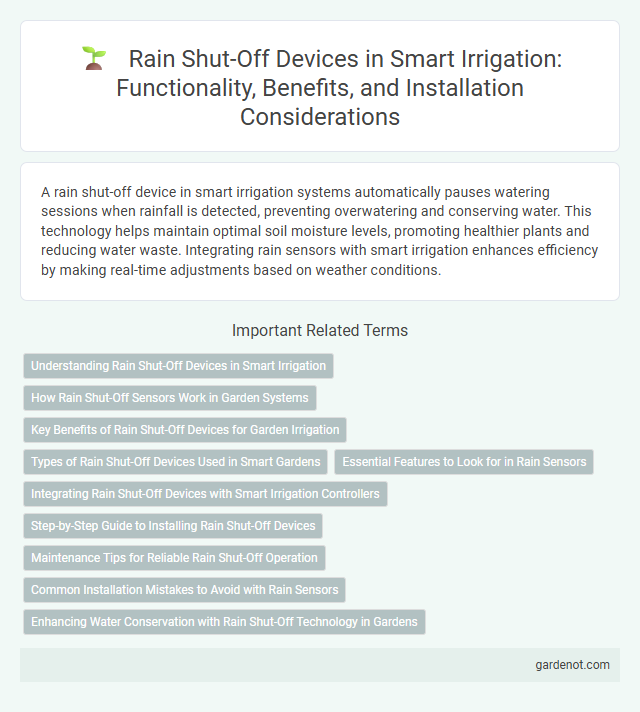A rain shut-off device in smart irrigation systems automatically pauses watering sessions when rainfall is detected, preventing overwatering and conserving water. This technology helps maintain optimal soil moisture levels, promoting healthier plants and reducing water waste. Integrating rain sensors with smart irrigation enhances efficiency by making real-time adjustments based on weather conditions.
Understanding Rain Shut-Off Devices in Smart Irrigation
Rain shut-off devices in smart irrigation systems automatically detect rainfall and temporarily halt watering schedules to prevent over-irrigation. These devices use sensors to measure precipitation levels and communicate with irrigation controllers for real-time adjustments, maximizing water efficiency. Integrating rain shut-off technology reduces water waste, lowers utility costs, and promotes sustainable landscaping practices.
How Rain Shut-Off Sensors Work in Garden Systems
Rain shut-off sensors detect moisture levels using electronic or mechanical probes placed within the garden irrigation system, automatically halting water flow when rainfall exceeds preset thresholds. These sensors integrate with smart irrigation controllers to prevent overwatering, conserving water and promoting plant health. By measuring real-time precipitation, rain shut-off devices optimize irrigation scheduling, enhancing efficiency and sustainability in garden systems.
Key Benefits of Rain Shut-Off Devices for Garden Irrigation
Rain shut-off devices for garden irrigation significantly conserve water by automatically halting irrigation during rainfall, reducing water waste and lowering utility bills. These devices enhance the efficiency of smart irrigation systems by preventing overwatering, which helps maintain optimal soil moisture levels and promotes healthier plant growth. Integration with weather sensors ensures precise irrigation scheduling, contributing to sustainable water management and environmental conservation.
Types of Rain Shut-Off Devices Used in Smart Gardens
Rain shut-off devices in smart gardens typically include mechanical rain sensors, which use a hygroscopic disc or tipping bucket to detect moisture and halt irrigation automatically, and electronic rain sensors that employ humidity sensors or weather data integration for precise control. Advanced models incorporate wireless connectivity, allowing integration with smart irrigation controllers for real-time irrigation adjustments based on rainfall. These devices enhance water conservation by preventing unnecessary irrigation during and after precipitation events, optimizing garden health and resource efficiency.
Essential Features to Look for in Rain Sensors
Rain shut-off devices for smart irrigation must have precise moisture detection to prevent overwatering and conserve water effectively. Essential features include quick response time to rainfall, compatibility with various irrigation systems, and easy installation for seamless integration. Accurate calibration and durability in diverse weather conditions ensure reliable performance and long-term savings.
Integrating Rain Shut-Off Devices with Smart Irrigation Controllers
Integrating rain shut-off devices with smart irrigation controllers enhances water conservation by automatically pausing irrigation during rainfall events. These devices detect precipitation levels in real-time, allowing controllers to adjust schedules based on weather data from local sensors or connected weather stations. This integration reduces water waste, prevents overwatering, and improves system efficiency by leveraging precise environmental inputs.
Step-by-Step Guide to Installing Rain Shut-Off Devices
Install a rain shut-off device by first turning off the main water supply and draining the irrigation system to prevent leaks. Next, mount the sensor in an open area ensuring it faces the direction where it can collect maximum rainfall, and securely connect it to the irrigation controller as per the manufacturer's wiring guide. Finally, test the system by simulating rainfall to confirm the device effectively halts irrigation during wet conditions, optimizing water conservation.
Maintenance Tips for Reliable Rain Shut-Off Operation
Regularly inspect and clean the rain shut-off device to remove debris, dirt, and insect nests that can interfere with sensor accuracy. Test the sensor functionality monthly by simulating rainfall to ensure the device correctly pauses irrigation cycles. Replace batteries annually and check wiring connections to prevent power failures and maintain uninterrupted operation.
Common Installation Mistakes to Avoid with Rain Sensors
Incorrect placement of rain shut-off devices, such as positioning sensors under eaves or near sprinklers, leads to inaccurate rainfall detection and inefficient irrigation. Failure to calibrate the rain sensor sensitivity can cause premature system shutdowns or delayed responses, wasting water or harming plants. Neglecting to regularly clean and maintain the sensor results in dirt buildup that impairs performance and reduces the device's reliability.
Enhancing Water Conservation with Rain Shut-Off Technology in Gardens
Rain shut-off devices significantly boost water conservation by automatically halting irrigation systems during rainfall, preventing water waste and soil over-saturation. These smart sensors detect moisture levels and adjust watering schedules accordingly, ensuring optimal hydration for plants while reducing water bills. Integrating rain shut-off technology with automated irrigation systems promotes sustainable garden management and supports environmental conservation efforts.
Rain shut-off device Infographic

 gardenot.com
gardenot.com